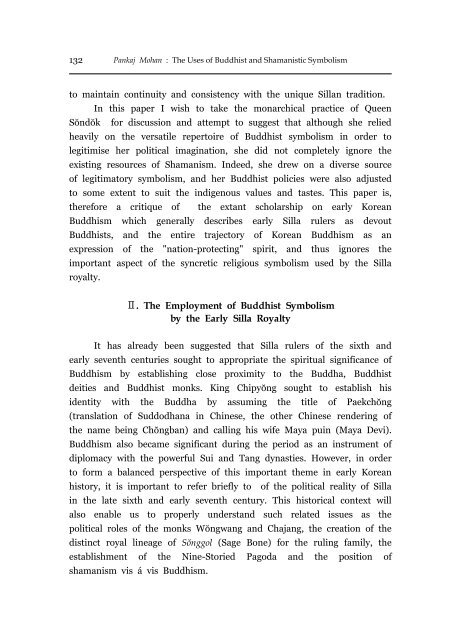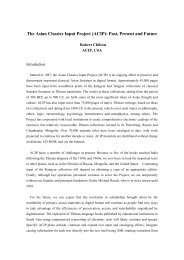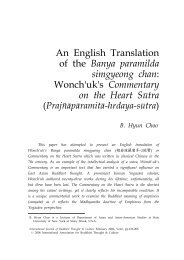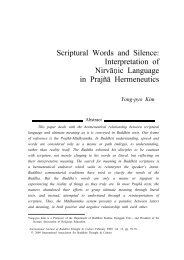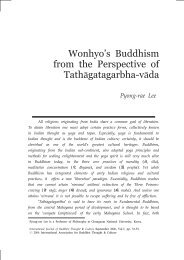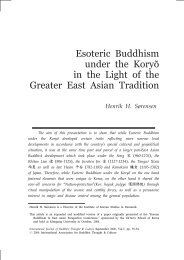You also want an ePaper? Increase the reach of your titles
YUMPU automatically turns print PDFs into web optimized ePapers that Google loves.
132<br />
<strong>Pankaj</strong> <strong>Moha</strong>n : The Uses of Buddhist and Shamanistic Symbolism<br />
to maintain continuity and consistency with the unique Sillan tradition.<br />
In this paper I wish to take the monarchical practice of Queen<br />
Sŏndŏk for discussion and attempt to suggest that although she relied<br />
heavily on the versatile repertoire of Buddhist symbolism in order to<br />
legitimise her political imagination, she did not completely ignore the<br />
existing resources of Shamanism. Indeed, she drew on a diverse source<br />
of legitimatory symbolism, and her Buddhist policies were also adjusted<br />
to some extent to suit the indigenous values and tastes. This paper is,<br />
therefore a critique of the extant scholarship on early Korean<br />
<strong>Buddhism</strong> which generally describes early Silla rulers as devout<br />
Buddhists, and the entire trajectory of Korean <strong>Buddhism</strong> as an<br />
expression of the "nation-protecting" spirit, and thus ignores the<br />
important aspect of the syncretic religious symbolism used by the Silla<br />
royalty.<br />
Ⅱ. The Employment of Buddhist Symbolism<br />
by the Early Silla Royalty<br />
It has already been suggested that Silla rulers of the sixth and<br />
early seventh centuries sought to appropriate the spiritual significance of<br />
<strong>Buddhism</strong> by establishing close proximity to the Buddha, Buddhist<br />
deities and Buddhist monks. King Chipyŏng sought to establish his<br />
identity with the Buddha by assuming the title of Paekchŏng<br />
(translation of Suddodhana in Chinese, the other Chinese rendering of<br />
the name being Chŏngban) and calling his wife Maya puin (Maya Devi).<br />
<strong>Buddhism</strong> also became significant during the period as an instrument of<br />
diplomacy with the powerful Sui and Tang dynasties. However, in order<br />
to form a balanced perspective of this important theme in early Korean<br />
history, it is important to refer briefly to of the political reality of Silla<br />
in the late sixth and early seventh century. This historical context will<br />
also enable us to properly understand such related issues as the<br />
political roles of the monks Wŏngwang and Chajang, the creation of the<br />
distinct royal lineage of Sŏnggol (Sage Bone) for the ruling family, the<br />
establishment of the Nine-Storied Pagoda and the position of<br />
shamanism vis á vis <strong>Buddhism</strong>.


